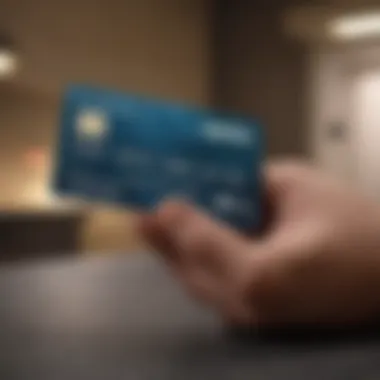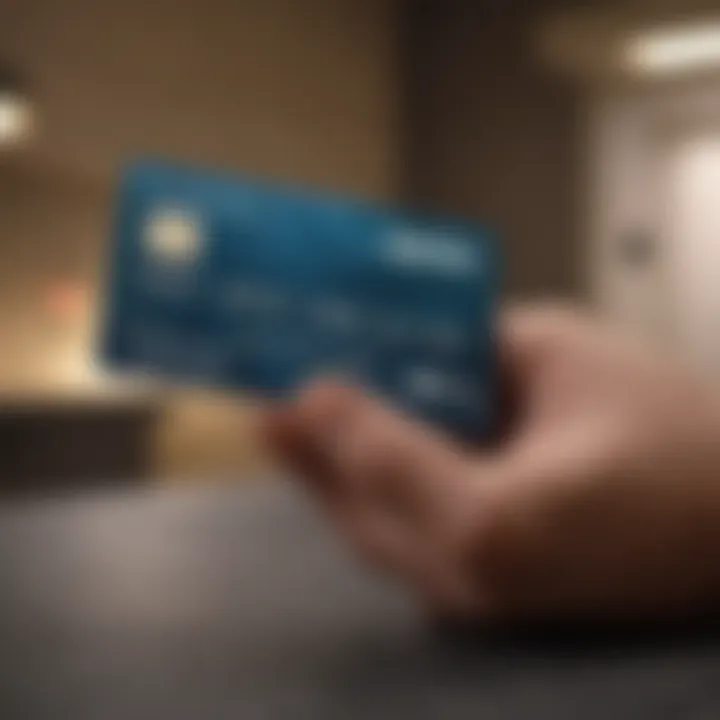Understanding Applied Bank Unsecured Credit Cards


Intro
In the world of personal finance, understanding different credit options can be a game-changer. There’s a vast ocean of financial products available, but not all suit everyone’s needs. Among them, applied bank unsecured credit cards stand out for various reasons. They offer flexibility, potentially welcome relief, and in some scenarios, financial freedom. But it’s crucial to dissect their features and implications carefully.
This guide serves as a roadmap, aimed at demystifying these credit cards, helping you navigate the waters of eligibility, application processes, management, and the direct implications on your credit score. So, grab a cup of your favorite beverage, and let’s dive into what makes these unsecured credit options tick.
Understanding Loans
Types of Loans
When you're in need of financing, the term "loan" can cover a lot of ground. While unsecured credit cards are not traditional loans, it’s helpful to understand other types of loans that may come into play, such as:
- Personal Loans: Generally offered by banks or credit unions, these loans can be used for anything from home repairs to debt consolidation.
- Student Loans: These help students fund their education, and they are typically backed by the government.
Loan Eligibility Criteria
Whether you're looking at personal loans or navigating credit cards, loan eligibility usually hinges on factors such as credit score, income level, and existing debts. In many cases, lenders look for:
- Credit History: A clean track record can make a big difference.
- Income Verification: Proof of income reassures the lender you can repay.
- Debt-to-Income Ratio: A lower ratio indicates you’re not over-leveraged.
Pros and Cons of Taking Out a Loan
Taking out a loan—or, in this scenario, applying for an unsecured credit card—has its own set of advantages and disadvantages. Here’s a quick rundown:
Pros:
- Improved Cash Flow: Helps bridge gaps in finances.
- Builds Credit History: Responsible use can positively impact your credit score.
Cons:
- Interest Rates: If you're not careful, interest rates can get steep.
- Potential for Debt: Mismanagement can lead to financial strain.
Navigating Credit Cards
Types of Credit Cards
Diving deeper into unsecured credit options reveals different types of credit cards:
- Cashback Cards: Give you a small percentage back on every dollar spent.
- Rewards Cards: Often tied to travel, these can earn points for future travel expenses.
- Balance Transfer Cards: Allow you to move existing debt from high-interest cards to a lower-interest option.
Credit Card Utilization Tips
To make the most of an unsecured credit card, it’s smart to manage utilization effectively. Here are a few pointers:
- Keep Balances Low: Aim to use less than 30% of your card’s limit.
- Pay on Time: This not only avoids late fees but reinforces healthy credit habits.
- Monitor Statements: Keeping an eye on your charges can prevent surprises and help you stay within budget.
Avoiding Common Credit Card Pitfalls
Even the most vigilant borrowers can stumble. Avoid these traps:
- Ignoring Fees: Be aware of annual fees, late payment penalties, and foreign transaction fees.
- Falling for Introductory Offers: They might seem attractive but read the fine print for hidden costs later on!
Remember: While unsecured credit cards can offer flexibility, prudent management is key to financially thriving.
In summary, the landscape of applied bank unsecured credit cards is both rich and fraught with potential pitfalls. Being informed is the best first step toward making savvy financial choices.
Understanding Unsecured Credit Cards
Unsecured credit cards are a significant tool in the world of personal finance, serving as a gateway to better financial health for many individuals. Unlike secured cards, which require a cash deposit, unsecured cards let users borrow against their credit limit without needing collateral. This opens up opportunities but also comes with responsibilities that are crucial to understand.
One must grasp that unsecured credit cards function mainly by evaluating a borrower's creditworthiness. Credit scores carry a weight here; higher scores typically yield better terms. Knowing this can guide residents looking to improve their financial standing or those needing credit for daily expenses or emergencies without tying up savings.
In this section, we’ll explore the core definitions and features of unsecured credit cards, as well as clarify how they differ from their secured counterparts—important distinctions for anyone considering a credit card application.
Definition and Key Features
Unsecured credit cards are essentially loans provided by financial institutions, allowing users to charge purchases up to a specific limit. They are often characterized by several defining features:
- No collateral required: Borrowers do not need to put down a deposit to access credit.
- Credit limits based on creditworthiness: Limits vary according to individual credit ratings, income, and repayment ability.
- Standard terms: While these cards may have introductory offers, terms generally include interest rates, annual fees, and payment schedules.
- Flexibility: Users can utilize them for various purchases, ranging from grocery bills to travel expenses.
Understanding these features is crucial as they guide one toward responsible credit usage, which can influence spending habits and repayment practices.
Differences Between Secured and Unsecured Cards
When contrasting secured and unsecured credit cards, several factors stand out:
- Deposit Requirement: Secured cards demand an upfront cash deposit, often equating to your credit limit. Unsecured cards require no such deposit, making them more accessible for many users.
- Risk Assessment: With secured cards, the risk is lower for issuers since they hold the cash collateral. Unsecured cards carry higher risk, often reserved for those with established credit histories.
- Fees and Rates: Unsecured cards can come with higher fees and interest rates, particularly for applicants with lower credit scores. Secured cards often have lower fees but may still incur costs for maintenance or transactions.
- Credit Score Impact: Both card types can help build or repair credit, but the potential for higher limits on unsecured cards might lead to quicker improvements in credit scores for responsible users.
"Understanding the fundamental differences between secured and unsecured credit cards allows consumers to make well-informed choices, mitigating financial risks and enhancing credit health."
In summary, recognizing the dynamics of unsecured credit cards is crucial. For potential cardholders, clarity on definitions and comparisons aids in evaluating which card aligns with their financial goals. This is the first step towards mastering the financial landscape surrounding credit card management.
Overview of Applied Bank
Understanding Applied Bank is crucial in the context of unsecured credit cards. This institution has established itself as a competent player in the financial sector, particularly catering to individuals seeking credit solutions. By exploring Applied Bank, one can gain insight into the offerings and unique qualities that set it apart from other banks in the market. Unsecured credit cards from Applied Bank not only serve basic borrowing needs but also present opportunities for building credit, thus making them an attractive option for those looking to improve their financial standing.
History and Reputation
Applied Bank was founded in 1996, and over the years, it has built a reputation for serving the needs of both consumers and businesses. The bank is recognized for its comprehensive suite of services, focusing on credit cards and small business loans. Its long-standing presence in the market reflects a commitment to customer service and financial wellness. Through various initiatives, it has garnered favorable reviews online, which emphasize its reliability and transparency in transactions, thus establishing trust with its clientele.


It is noteworthy that banks accumulate reputations based on their ability to deliver on promises. Those interested in unsecured credit cards should consider Applied Bank’s track record for both good and bad press. Positive feedback about their customer service can provide peace of mind, while reports of high-interest rates on certain products might raise red flags for potential customers.
Target Market and Services Offered
Applied Bank primarily targets individuals who may have limited access to traditional banking services or those looking to rebuild their credit. This includes first-time credit users, recent graduates, and individuals with past credit issues. By providing unsecured credit cards with flexible qualification criteria, the bank opens its doors to a demographic often overlooked by larger financial institutions.
The services provided include:
- Unsecured Credit Cards: These cards allow users to make purchases without needing to deposit cash upfront. A prudent option for those focused on rebuilding credit.
- Revolving Lines of Credit: This provides borrowers with flexibility, letting them withdraw money when needed without the hassle of reapplying.
- Business Solutions: Applied Bank also caters to small businesses, offering tailored financing solutions that allow them to manage cash flow and invest in growth.
Understanding these facets allows potential applicants to gauge whether the offerings align with their financial goals and lifestyle. Furthermore, tapping into a bank that serves your specific needs could foster a healthier financial future.
Applied Bank Unsecured Credit Card Features
Understanding the features of applied bank unsecured credit cards is vital for anyone considering this financial option. These cards not only open up access to credit but also come with specific advantages and potential downsides that should not be overlooked. Knowing what to expect can help individuals make decisions that align with their financial well-being.
Credit Limits and Terms
When it comes to credit limits, applied bank unsecured credit cards present a range of possibilities. Generally, these limits can vary widely based on a cardholder’s creditworthiness and financial history. For instance, first-time credit card users or those with low credit scores might be approved for a lower limit, often starting around $300 to $500. However, responsible usage, which includes making on-time payments, can enable one to request an increase over time.
Specific terms associated with these cards might differ, reflecting the bank’s policies. Some cards offer introductory periods with attractive limits, while others base their limits on existing financial products from the same institution. It's always prudent to read the fine print—keep an eye out for potential expiration of introductory rates or fees that can sneak up on users.
Interest Rates and Fees
Interest rates on applied bank unsecured credit cards typically fall within a broad spectrum. These rates can significantly impact how much one pays for purchases carried on the card. If a cardholder doesn’t pay off their balance in full, they may face interest rates that range anywhere from 15% to 25% or more.
- Annual Fees: Many unsecured cards impose annual fees, which can be anywhere from $0 to over $100 depending on the benefits offered. Always verify what benefits come with higher fees; sometimes, it may not be worth it.
- Late Payment Fees: Failing to pay on time could result in hefty late fees, which further compounds the interest one has to repay.
- Foreign Transaction Fees: For those planning to travel, looking out for foreign transaction charges is a must. Some cards charge up to 3% on purchases made outside the United States.
Learning to navigate these fees can protect you from unnecessary charges while also aiding in effective financial planning.
Rewards and Incentives
The competitive landscape of unsecured credit cards often means that rewards programs are part of the package. Applied bank unsecured credit cards may offer cash-back rewards, points per purchase, or airline miles, which can be a boon for users who often travel or make substantial purchases.
- Cash-Back Programs: Many cards offer a small percentage back on all purchases or bonus percentages on categories like groceries or gas.
- Points Programs: Some cards allow accumulation of points that can be redeemed for merchandise, travel, or experiences. Keep in mind, however, that redemption requirements vary and can often be confusing—a little forethought can go a long way.
- Promotional Offers: New cardholders might be tempted with sign-up bonuses, enticing them to spend a specific amount within the first few months. These can be lucrative but should be approached with caution to avoid overspending.
In summary, exploring the features of applied bank unsecured credit cards unveils not just advantages, but discerning readers should pay attention to the potential caveats. Education regarding credit limits, interest rates, fees, and reward structures leads to informed decisions, ultimately contributing to a well-managed financial life.
"In finance, information is power. The more you know, the better your decisions can be."
By deeply understanding these features, cardholders position themselves to maximize the benefits while minimizing the pitfalls associated with unsecured credit products.
Eligibility Criteria
Understanding the eligibility criteria for applying for an unsecured credit card is crucial. It offers potential applicants insights into what they need to qualify. Meeting these requirements often opens the door to financial opportunities and helps consumers avoid unnecessary disappointment during the application process. Moreover, awareness of these criteria can aid individuals in building a more robust financial profile.
Basic Requirements
To kick things off, let’s pin down the basic requirements needed to apply for an Applied Bank unsecured credit card. Often, these can vary slightly between lenders, but they generally include:
- Age Requirement: Applicants must typically be at least 18 years old, although in some states, a person might need to be older due to legal provisions.
- Residency Status: Most institutions prefer applicants who are U.S. citizens or permanent residents. Non-residents may face additional hurdles.
- Income Verification: A stable source of income is paramount. Lenders often require proof of income, which demonstrates the ability to repay the credit balance. This can include pay stubs, tax returns, or bank statements.
- Bank Account: Having an operational bank account might be necessary. This allows lenders to deposit funds directly or set up electronic payments.
- Social Security Number (SSN): To run a credit check, an SSN is generally required. This helps in assessing the individual's credit history and score.
These criteria serve to mitigate risk for lenders, helping them understand the financial behaviors of applicants. Missing even one of these boxes often leads to an instant rejection, so it’s best to be well-prepared.
Impact of Credit Score
Now, turning to the impact of credit score, this crucial number serves as a beacon for lenders. Generally, a healthier score opens up better options for credit cards, including those from Applied Bank. While there’s no set requirement universally applied across lenders, here’s the lowdown:
- Generally Accepted Range: A score of at least 580 is often considered the minimum for unsecured credit cards. However, scores around 700 or higher may yield even more favorable terms and limits.
- Effects of Poor Score: If your score hangs in the lower range, you might find that not only do you face higher interest rates, but your credit limit could also be impacted. It means you may get stuck with less purchasing power, which can hinder your financial flexibility.
A credit score is more than just a number; it’s a reflection of your credit behavior. Treat it with care, and it can open many doors.
- Credit Mix Considerations: Sometimes, having a mix of credit (like installment loans and credit cards) will show lenders you're capable of managing different types of credit responsibly.
In summary, understanding both the basic requirements and the significance of your credit score provides a clearer picture of where you stand in the consumer credit landscape. Always check your score before applying; it helps you strategize to improve your chances of approval and better terms.
Application Process
Understanding the application process for an unsecured credit card is more than just filling out a form; it’s a vital step toward achieving financial flexibility. This process often determines not only whether you will receive the credit but also the terms attached to it. The right credit card can open doors, offering rewards, cash back, or lower interest rates that can ease your financial burden.
An application process that's straightforward can make all the difference. When individuals considering an unsecured card understand what to expect, it allows them to prepare adequately. This preparation often results in successful applications and better credit terms. Whether you're a seasoned credit user or a newcomer, knowing the intricacies can save you time and potential financial loss.
Step-by-Step Guide
- Check Your Credit Score: Before you dive into the application, it’s wise to check where your credit stands. Understanding your score can help in choosing the right card. Different cards accept different credit levels, and having an idea of your creditworthiness will steer you in the right direction.
- Select the Right Card: Applied Bank offers various cards, so it’s good to sort through their options. Take a serious look at the features, fees, and interest rates of each card. For instance, some may come with higher fees but offer significant rewards; others might have lower rates but fewer benefits.
- Gather Necessary Documentation: Be ready with your personal information, including Social Security number, income details, and employment status. Some cards might also request identification, which speeds up the process.
- Fill Out the Application: Once you’ve selected the card and have your documents in hand, it’s time to fill out the application. You can often do this online, which is generally faster. Pay attention to each field; mistakes can lead to delays or rejection.
- Submit & Wait for Approval: After submission, it’s a waiting game. Many times, you’ll receive an instant decision, but sometimes it can take a few days. During this waiting period, try not to apply for multiple credit cards, as that can hurt your credit score.
- Receive Your Card and Review Terms: Once approved, you’ll get your card in the mail. It's crucial to read the terms and conditions; knowing how your interest rates and fees work can save you from future woes.
Tips for a Successful Application
- Be Honest: Fabricating information might seem tempting, but is one way to guarantee denial. Lenders appreciate transparency, presenting a better case for your application.
- Have a Co-Signer: If your credit score leaves something to be desired, having a co-signer can increase your chances. Choose someone with a solid credit history, but make sure they understand the responsibility involved.
- Timing is Key: Timing your application can have an impact. Avoid applying shortly after a major purchase or another credit inquiry, as it might lower your score temporarily.
- Review Your Credit Report: Errors can sometimes sneak in, impacting your credit. Regularly reviewing your report, including correcting mistakes, places you in a stronger position.
- Consider Pre-Approval Options: Some banks provide pre-approval processes that won’t affect your credit score. This is a good way to assess your eligibility and interest rates with little risk.
Remember, successfully navigating the application process is just the first step; staying informed about your credit card's management is key to maximizing its benefits.
Managing Your Applied Bank Unsecured Credit Card
Managing your Applied Bank unsecured credit card is not just about keeping track of payments or knowing your limit. It involves a detailed understanding of how to navigate the potential benefits and challenges presented by unsecured credit. Recognizing the nuances of managing such a card can lead to improved financial health and heightened credit scores.
Understanding the features of your card, such as the credit limits and interest rates mentioned earlier, will empower you to use your card wisely. The ability to leverage this financial tool can enhance your spending power while maintaining control over your budget. This section aims to equip you with strategies that not only optimize the use of your credit card but also safeguard against common missteps that could result in financial strain.
Strategic Spending Practices


In the world of credit cards, every dollar counts. Having a spending strategy can go a long way in ensuring that your card serves you well instead of becoming a burden. Here are some practices that can help in managing your spending efficiently:
- Prioritize Essentials:
Focus on necessary expenses. This minimizes impulse purchases which can quickly rack up debt. - Set a Monthly Budget:
Create a budget that aligns with your income and stick to it. By designating specific amounts for various needs, you can avoid overspending. - Make Use of Alerts:
Many credit card issuers, including Applied Bank, allow you to set alerts for spending thresholds. Use these tools to keep tabs on your expenditures. - Track Your Spending Regularly:
Don’t wait for the monthly statement; check your account online frequently. This will give you a clearer picture of your financial habits and help you adjust if needed.
Implementing these strategies can drastically reduce the likelihood of accruing unmanageable debt. Also, by maintaining a low balance relative to your limit, you can positively influence your credit score.
Payment Scheduling and Interest Management
Payment practices and management of interest rates play a crucial role in your financial journey. Missing out on timely payments can lead to high fees and may tarnish your credit score. Here are some effective ways to schedule payments and ensure you're managing interest correctly:
- Automate Payments:
Set up autopay for at least the minimum payment. This ensures you’re never late, safeguarding your credit score from potential dents. - Pay More Than the Minimum:
If possible, aim to pay more than just the minimum required. This will help you pay down your balance faster and minimize interest charges. - Stay Informed About Interest Rates:
Keep an eye on the variable interest rates that might apply to your card. Understanding when and why rates change will help you strategize your payments better. - Utilize Grace Periods:
Know your card’s billing cycle. Making payments during the grace period can often eliminate interest on new purchases, giving you a financial edge. - Monitor Your Statements:
Regularly reviewing your credit card statements helps you catch any mistakes or unauthorized charges early, allowing you to address them before they escalate.
These conscious efforts can lead to a smoother financial experience and stave off any unwanted debt traps. Stay proactive in monitoring your payments and terms to maintain a healthy relationship with your credit card.
By embracing these methods, you’ll find that managing your Applied Bank unsecured credit card not only becomes easier but also more beneficial in the long run. Mastering credit management can play a pivotal role in achieving financial stability.
Impact on Credit Score
Understanding how an unsecured credit card influences your credit score is essential for anyone thinking about applying for one. Your credit score can greatly affect the terms of loans you take in the future, including mortgages and personal loans. It’s not just a number; it reflects your financial behaviors and risks to lenders.
Understanding Credit Utilization
One of the key factors that contributes to your credit score is your credit utilization ratio. This ratio is calculated by dividing your total credit card balances by your total credit limits. For example, if you have a total limit of 10,000 dollars and a balance of 3,000 dollars, your credit utilization rate stands at 30%. Most experts recommend maintaining this ratio below 30% to avoid negative impacts on your score.
- Lower Utilization: Keeping your balances low relative to your total available credit shows lenders you manage credit wisely.
- Impact on Score: High utilization ratios may signal to lenders that you're over-relying on credit, which can pull your score down.
Moreover, it’s important to note that even a single late payment can drastically increase your utilization ratio, leading to an adverse effect on your credit score. Effective management practices include paying off your balance in full whenever possible or making multiple payments throughout the month to keep your utilization low.
How Unsecured Credit Affects Creditworthiness
The mere act of opening an unsecured credit card can have immediate implications for your creditworthiness. These cards typically come with zero security deposits, making them easier to obtain. However, with this opportunity comes responsibility.
- New Credit Inquiry: Each application results in a hard inquiry on your credit report, which may slightly lower your score, at least in the short term. A well-managed unsecured credit card can build your score over time.
- Payment History: This is the most significant factor in your credit score. Ensuring timely payments reinforces your reliability.
- Credit Mix: Lenders like to see a good blend of credit types. Unsecured credit cards diversify your credit sources, which can boost your score.
"Managing your unsecured credit effectively can open doors, paving the way for better interest rates on loans and other credit products in the future."
Common Pitfalls and How to Avoid Them
Understanding the potential pitfalls when using an unsecured credit card from Applied Bank is essential for maintaining financial stability. The risk of accruing unmanageable debt and missing payment deadlines can have serious consequences. Recognizing these challenges allows consumers to adopt practical strategies to mitigate risks and make informed decisions, ultimately protecting their credit profile and financial well-being.
Accruing Unmanageable Debt
When it comes to unsecured credit cards, the thrill of having accessible credit can turn into a slippery slope. It’s easy to charge a few extra purchases here and there, thinking you’ll pay it off later. However, panic can set in if debt suddenly spirals out of control. One key aspect of managing an unsecured credit card is recognizing your spending habits and understanding where temptation lurks.
To avoid getting tangled in a web of debt, consider the following:
- Set a Strict Budget: Ensure that your monthly expenses do not exceed your income. Creating clear boundaries between needs and wants can help keep spending in check.
- Regularly Review Statements: Monitoring transaction history helps identify unwanted spending patterns early. Rather than being surprised by the statement, staying alert keeps your financial health intact.
- Use Alerts and Notifications: Leveraging bank services for transaction alerts allows you to stay aware of your spending in real-time, prompting necessary adjustments if needed.
"A penny saved is a penny earned." This adage rings true when managing an unsecured credit card. Keeping tabs on spending effectively can prevent the weight of debt from becoming unbearable.
Missing Payment Deadlines
Another common pitfall with unsecured credit cards is the risk of missing payment deadlines. Often, in life’s hustle and bustle, it’s easy to forget a due date. Missing payments can trigger late fees, increased interest rates, and damage to your credit score. This cascading effect can lead to financial setbacks that may take time to recover from.
To avoid falling into this trap, here are a few tips that can help:
- Create a Payment Calendar: Marking due dates on a calendar or setting up reminders in your device can help ensure you never overlook a payment. Consistency is key.
- Enroll in Auto-Pay: Many banks offer the option to automatically deduct the minimum payment from your bank account. This feature can serve as a safety net and protect your credit score from potential drops. However, ensure sufficient funds are in your account to avoid overdraft fees.
- Prioritize Payments: If you have multiple obligations, always prioritize making at least the minimum payment on your credit card to prevent any adverse effects on your credit score.
Overall, navigating unsecured credit cards requires clear awareness and proactive management. Keeping these common pitfalls in mind will not only bolster your financial habits but will also pave the way for a smoother relationship with credit.
Alternative Options
When it comes to managing one’s finances, especially in the context of unsecured credit cards, exploring alternative options can be quite enlightening. Options like secured credit cards and credit building loans can serve as crucial stepping stones, not only for those looking to bolster their credit scores but also for individuals keen on establishing or repairing their financial health. In this section, we dive into these alternatives, emphasizing their relevance and potential advantages.
Secured Credit Cards
Secured credit cards often come up as an accessible alternative for those who may struggle with traditional unsecured credit offerings. The concept here is simple: to obtain a secured card, usually, you need to put down a cash deposit, which essentially acts as your credit limit. If you deposit $500, for instance, that becomes the ceiling for your expenditures. This provides a safety net for the lender while offering you a way in without the high stakes often associated with unsecured credit cards.
Why consider a secured card?
- Easier Approval: Because secured cards involve a cash deposit, approval can be less stringent, making them valuable for individuals with poor or no credit history.
- Credit Building: Responsible usage of a secured card can gradually improve your credit score. Timely payments contribute positively to your credit reports, potentially opening doors to better credit products.
- Less Financial Risk: Fewer risks mean more peace of mind. As you are spending within your limit (your deposit), it's less likely you'll rack up unmanageable debt.
Not all secured cards are created equal, though. Different issuers have varying fees and features, so doing your homework is essential before taking the plunge.
Credit Building Loans
Another option gaining traction are credit building loans. These loans work differently from traditional loans in that the borrowed amount typically stays in a savings account until it’s paid off. You are basically borrowing your own money with interest. This unique format serves dual purposes: it builds your credit and sets aside funds for future needs.
The benefits of credit building loans include:
- Establishing a Positive Payment History: Making regular, on-time payments is a key component in boosting your credit score. By paying off a credit building loan, you’re doing just that.
- Saving Money for Future Use: Once you've completed your payments, the totality of the loan amount, minus interest and fees, becomes available to you. Essentially, you are saving while you're building credit.
- Ideal for Financial Discipline: The format of credit building loans encourages disciplined money management. It can serve as a training ground for future loans or credit cards.
"Opting for secured credit cards or credit building loans can lay the groundwork needed for higher credit limits and more favorable financing options in the future."
In the realms of financial products, alternatives like secured cards and credit building loans can be lifelines for many. Whether you’re sidelined by poor credit or simply wish to build a solid financial future, these options can offer structured ways to take control of your credit journey, ultimately aiding in achieving your long-term financial goals.
Comparative Analysis with Other Credit Options
Navigating the current credit landscape can be like trying to solve a puzzle; each piece represents a different financial tool. In this section, we’ll contrast applied bank unsecured credit cards with other options, shedding light on their unique attributes. This analysis not only helps consumers make educated decisions but also emphasizes the advantages and pitfalls associated with each option.


Unsecured vs. Secured Credit Cards
Unsecured and secured credit cards serve different audiences and purposes. Unsecured credit cards are typically easier to obtain, as they don't require upfront collateral, making them appealing to a broader user base. Individuals with a healthy credit score can access higher limits without needing to put down a deposit.
On the flip side, secured credit cards demand an initial deposit, which usually acts as your credit limit. This can be a wise option for anyone looking to rebuild a credit history, as it reduces the lender’s risk. Let’s look at some key comparisons between the two:
- Risk Assessment: Unsecured cards rely on your creditworthiness, while secured cards mitigate risk with a deposit.
- Credit Building: Both options help build credit, but secured cards may be more beneficial for individuals with low credit ratings.
- Interest Rates: Unsecured cards tend to have higher interest rates compared to secured ones. When you don’t pay your balance on time, the costs can add up quickly.
In summary, while unsecured cards offer flexibility and convenience, secured cards provide a solid way to improve credit scores for those starting out or recovering.
Personal Loans Versus Credit Cards
When considering how to borrow money, there are stark differences between personal loans and credit cards. Personal loans offer a lump sum for an agreed period, usually at a fixed interest rate. This predictability can be a double-edged sword, as it allows for firm planning of repayments but lacks the flexibility of a revolving credit option.
Conversely, credit cards provide continuous access to funds up to a predetermined limit. They shine through everyday purchases and allow for flexibility in payment; however, this can lead to potential debt traps, especially if one is not vigilant about repayment.
Here are some essential points to consider when comparing personal loans and credit cards:
- Flexibility: Credit cards offer more flexibility in how much to spend and when to pay, while personal loans are rigid in structure.
- Interest Rates: Generally, personal loans come with more favorable rates, especially for borrowing larger sums, while credit cards often have higher interest rates.
- Usage: Credit cards are better for regular purchases, while personal loans are better suited for significant one-time expenses.
Ultimately, the choice hinges on your financial needs and habits. If you can manage spending wisely, a credit card can serve you well. However, for planned expenses, a personal loan might be the better route.
"Choosing the right financial product can significantly impact one’s credit health and overall financial success."
Understanding these choices empowers consumers to make decisions that align with their financial goals.
Long-Term Financial Implications
When diving into unsecured credit options like those offered by Applied Bank, it’s essential to not just focus on the immediate benefits—like acquiring a credit card without the need for collateral—but also to understand how these choices can ripple through one's financial future. This section delves into the long-term financial considerations related to taking on unsecured credit. Responsible usage can foster growth in one's credit profile, while irresponsible choices could lead to a cycle of debt that is hard to break.
Debt Management Strategies
Managing debt effectively when utilizing unsecured credit is paramount. Here are some actionable strategies:
- Create a Budget: Knowing where your money is going each month helps in allocating funds specifically for credit card payments. A strictly followed budget can mitigate the risk of overspending.
- Set Alerts: Many mobile banking apps allow users to set reminders for payment due dates. This can help you avoid late fees and interest rate hikes, keeping your credit healthy.
- Pay More than the Minimum: If you only make minimum payments, a significant portion of your payment will go towards interest rather than reducing the principal. Paying more than the minimum can save you money in the long run.
- Consolidate Debts if Necessary: If you find yourself juggling multiple credit cards, consider consolidating your high-interest debts. There are options like personal loans designed for this purpose, which often come with lower interest rates.
These strategies can empower individuals to take control over their credit card usage, reduce stress, and lead to better financial outcomes. The goal is to maintain a balance where one can fully utilize the credit card benefits without falling into a debt trap.
Planning for Future Credit Needs
Unsecured credit cards are not just short-term solutions but can play a central role in your overall financial strategy. To effectively plan for future credit needs, consider the following:
- Build a Positive Credit History: Consistently managing your Applied Bank unsecured credit card in a responsible manner can establish a robust credit history. This record will be essential when applying for larger loans in the future.
- Understand Your Credit Utilization: Keeping the balance to less than 30% of available credit is ideal. A good utilization ratio not only affects your credit score positively but also shows future creditors that you can manage your debts wisely.
- Anticipate Changes in Financial Situation: Jobs change, expenses rise and fall. It’s important to plan ahead for possible shifts in income. Factors such as children’s education or home ownership often necessitate adjustments in credit needs.
- Research Other Credit Options: Don’t wait until you need a large loan to explore your options. Maintaining an awareness of personal loans, mortgages, or even lines of credit can prepare you for making informed decisions later.
By adopting these proactive planning measures, individuals can navigate their financial future with assurance and clarity. Unsecured credit cards, when managed prudently, can open doors to financial opportunities that might otherwise remain shut.
Consumer Rights and Protections
Understanding consumer rights and protections is key when dealing with unsecured credit cards. It establishes a safety net for individuals, offering assurance and resources should unexpected issues arise. Ignoring these rights might leave one feeling vulnerable in a world that's usually bogged down with complex financial jargon. In the realm of unsecured credit, having clarity and the right knowledge can empower consumers to make informed choices and ensure they are treated fairly.
Understanding Regulatory Framework
The regulatory framework surrounding consumer credit is multifaceted, encompassing various laws and regulations designed to guard urban and rural buyers. These laws promote transparency and accountability among issuers of unsecured credit cards. One notable example being the Truth in Lending Act (TILA), which obliges lenders to disclose important terms of the agreement.
Consider the following aspects:
- Clarity of Terms: Consumers should receive clear information about interest rates, fees, and payment deadlines. This transparency helps in making educated financial decisions.
- Fair Lending Practices: Institutions must adhere to regulations that prevent discriminatory lending based on age, race, or gender.
- Data Protection: Credit card issuers must ensure that personal information remains confidential, safeguarding customers from data breaches.
By comprehending the regulatory landscape, individuals can navigate their rights and also recognize when those rights may be breached.
Dispute Resolution Processes
In the unfortunate event of disputes, understanding the specific resolution processes is crucial. Many consumers may find themselves in situations where misunderstandings about charges or services arise, and knowing how to effectively address these can save time and frustration.
Here are some key components of the dispute resolution process:
- Initial Steps: Should issues arise, the first step typically involves contacting the issuer’s customer service to communicate concerns. Many disagreements can be settled quickly with a simple phone call.
- Formal Complaints: If the issue remains unresolved, consumers can escalate concerns to formal channels, such as filing a complaint with relevant financial regulatory authorities.
- Documentation and Evidence: Keeping a well-organized record of all transactions, statements, and communications is imperative. This documentation is invaluable when substantiating a claim.
It’s vital for consumers to remain proactive about their rights; the first line of defense is often an informed approach.
Overall, fostering a good understanding of consumer rights and protections equips individuals with the knowledge to navigate unsecured credit cards confidently. It ensures that they are never left in the lurch when it comes to managing unexpected issues that may arise.
Future of Unsecured Credit Cards
As we look toward the horizon of financial products, understanding the future of unsecured credit cards becomes pivotal. This area has already seen shifts in consumer behavior, technology, and financial regulations, all shaping how these products are perceived and used. In a world where financial literacy and credit access are constantly evolving, acknowledging these factors is key for consumers and industry stakeholders alike. Navigating this landscape can have significant implications for credit management and financial health.
Market Trends and Projections
The landscape of unsecured credit cards is on the brink of transformation. One of the primary trends is the digitization of banking services. A significant number of consumers are leaning toward online financial management tools, making digital applications for credit cards the norm instead of the exception. One element seen in this trend is the integration of budgeting tools within bank apps, helping users manage their spending and expenditures more proactively.
In addition to digital advancements, we might see an upward spike in promotional offers, mostly to attract a younger demographic. Many companies are now offering incentives like cashback, travel points, and exclusive discounts for certain merchants. These rewards are a compelling lure for tech-savvy consumers, eager to maximize every dollar spent.
Another trend is increasing competition among issuers. With many banks and financial institutions chasing the same customer base, it’s not just about offering basic features anymore. Companies could introduce card programs that focus on niche markets, such as cards tailored for students or cards targeting frequent travelers. Therefore, keeping an eye on market movements can help potential applicants find the most suited options for their needs.
"The landscape of unsecured credit is changing, making it imperative for consumers to stay informed to make sound financial choices."
Potential Innovations and Changes
Innovation is another critical aspect to consider when discussing the future of unsecured credit cards. The advent of artificial intelligence and machine learning is creating a monumental shift. Lenders are increasingly relying on sophisticated algorithms to assess creditworthiness. This trend might mean a move towards more personalized credit offers tailored to individual spending habits and financial situations.
Additionally, there are ongoing discussions about incorporating blockchain technology. A system grounded in blockchain could lead to heightened transparency and security, potentially nerve-wracking for some but beneficial in preventing fraud. Furthermore, if implemented correctly, this could streamline the approval process, reducing the bureaucratic red tape that often delays access to credit.
Finally, sustainability is becoming a popular focal point. The future may hold eco-friendly credit cards made from recyclable materials or programs that allow users to allocate a portion of their credit card rewards to environmental initiatives or charities. This kind of forward-thinking could resonate well with environmentally conscious consumers, marrying financial responsibility with social and ecological awareness.
Through understanding these emerging trends and potential innovations, consumers can prepare themselves for what’s ahead, ensuring they choose credit options wisely and responsively.







